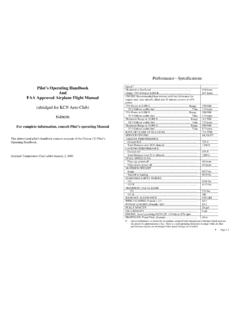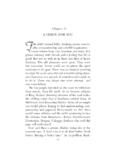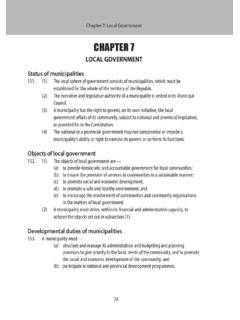Transcription of section 152(c)) or a “qualifying relative” (as defined in ...
1 Part III Administrative, Procedural, and Miscellaneous qualifying relative for Purposes of section 152(d)(1) Notice 2008-5 PURPOSE This notice provides guidance under section 152(d) of the Internal Revenue Code for determining whether an individual is a qualifying relative for whom the taxpayer may claim a dependency exemption deduction under section 151(c). section 152(d)(1)(D) provides that an individual is not a qualifying relative of the taxpayer if the individual is a qualifying child of any other taxpayer. This notice clarifies that an individual is not a qualifying child of any other taxpayer if the individual s parent (or other person with respect to whom the individual is defined as a qualifying child) is not required by section 6012 to file an income tax return and (i) does not file an income tax return, or (ii) files an income tax return solely to obtain a refund of withheld income taxes.
2 BACKGROUND section 151 allows a taxpayer a deduction for each individual who is a dependent ( as defined in section 152) of the taxpayer for the taxable year. section 152(a) provides that the term dependent means a qualifying child ( as defined in 2section 152(c)) or a qualifying relative ( as defined in section 152(d)). The terms qualifying child and qualifying relative were added to section 152 by section 201 of the Working Families Tax Relief Act of 2004 (WFTRA), Pub. L. No. 108-311, 118 Stat. 1169, effective for taxable years beginning after December 31, 2004. WFTRA established a uniform definition of a qualifying child pursuant to section 152(c) for determining whether a taxpayer may claim certain child-related tax benefits, namely head of household filing status, the earned income credit, child tax credit, the child and dependent care credit, and the dependency exemption deduction.
3 See 2(b), 32, 24, 21, 152. WFTRA also established the term qualifying relative to identify individuals (other than a qualifying child) for whom a dependency exemption deduction may be allowed. Definition of a qualifying child and qualifying relative section 152(c)(1) defines a qualifying child of a taxpayer as an individual who: (A) bears a certain relationship to the taxpayer, (B) has the same principal place of abode as the taxpayer for more than one-half of the taxable year, (C) meets certain age requirements, and (D) has not provided over one-half of his or her own support for the calendar year. section 152(d)(1) provides, in part, that to be a qualifying relative of a taxpayer, an individual must: (A) bear a certain relationship to the taxpayer, (B) have gross income for the calendar year that is less than the exemption amount ( as defined in section 151(d)), and (C) derive over one-half of his or her support for the calendar year from the taxpayer.
4 In addition, section 152(d)(1)(D) requires that the individual not be a qualifying child of the taxpayer or of any other taxpayer for the taxable year. section 3152(d)(2)(H) provides that a qualifying relative may include an individual who has the same principal place of abode as the taxpayer and who is a member of the taxpayer s household. Requests for guidance Commentators have indicated that section 152(d)(1)(D) may lead to unintended tax consequences that differ from the tax consequences under prior law. For example, commentators cite an example of a taxpayer who supports as members of her household two minor orphans who are brother and sister. The commentators question whether the children are qualifying children of any other taxpayer ( , one another), thus making the taxpayer ineligible to claim dependency exemption deductions for the children.
5 Commentators have requested that the Service issue written guidance under section 152(d)(1)(D). Prior to amendment by WFTRA, under sections 151 and 152 a taxpayer could claim a dependency exemption deduction for an unrelated child who was a member of the taxpayer s household for the entire year, provided all relevant requirements of section 151 and 152 were satisfied. WFTRA generally permits taxpayers to continue to apply the dependency exemption rules of present law to claim a dependency exemption for a qualifying relative who does not satisfy the qualifying child definition. See Rep. 696, 108th Cong., 2d Sess. at 56, 62, and 64 (2004). The Service, therefore, concludes that a taxpayer otherwise eligible to claim a dependency exemption deduction for an unrelated child is not prohibited by section 152(d)(1)(D) from claiming the deduction if the child s parent (or other person with respect to whom the child is defined as a qualifying child) is not required by section 6012 to file an 4income tax return and (i) does not file an income tax return, or (ii) files an income tax return solely to obtain a refund of withheld income taxes.
6 See Rev. Rul. 54-567, 1954-2 108, aff d Rev. Rul. 65-34, 1965-1 86. APPLICATION For purposes of section 152(d)(1)(D), an individual is not a qualifying child of any other taxpayer if the individual s parent (or other person with respect to whom the individual is defined as a qualifying child) is not required by section 6012 to file an income tax return and (i) does not file an income tax return, or (ii) files an income tax return solely to obtain a refund of withheld income taxes. EXAMPLES Example 1. A supports as members of his household for the taxable year an unrelated friend, B, and her 3-year-old child, C. B has no gross income, is not required by section 6012 to file an income tax return, and does not file an income tax return for the taxable year.
7 Accordingly, because B does not have a filing requirement and did not file an income tax return, C is not treated as a qualifying child of B or any other taxpayer, and A may claim both B and C as his qualifying relatives, provided all other requirements of sections 151 and 152 to qualify for the deduction are met. Example 2. Same facts as Example 1, except that B has earned income of $1,500 during the taxable year 2006, had income tax withheld from her wages, and is not required by section 6012 to file an income tax return. With one qualifying child, B may claim the earned income credit (EIC) in the amount of $519 for the taxable year. B files an 5income tax return solely to obtain a refund of withheld income taxes and does not claim the EIC. Accordingly, because B does not have a filing requirement and filed only to obtain a refund of withheld income taxes, C is not a qualifying child of B or any other taxpayer, and A may claim both B and C as his qualifying relatives, provided all other requirements of sections 151 and 152 to qualify for the deduction are met.
8 Example 3. Same facts as Example 1, except that B has earned income of $8,000 during the taxable year 2006, had income tax withheld from her wages, and is not required by section 6012 to file an income tax return for the taxable year. With one qualifying child, B may claim the EIC in the amount of $2,729 for the taxable year. B files an income tax return for the taxable year to obtain a refund of withheld income taxes, and B claims the EIC on the return. Accordingly, because B filed an income tax return to obtain the EIC, and not solely to obtain a refund of withheld income taxes, C is a qualifying child of another taxpayer, B, and A may not claim C as a qualifying relative . EFFECTIVE DATE This notice applies to taxable years beginning after December 31, 2004. DRAFTING INFORMATION The principal author of this notice is Christina Glendening of the Office of Associate Chief Counsel (Income Tax & Accounting).
9 For further information regarding this notice, contact Ms. Glendening at (202) 622-4920.

















